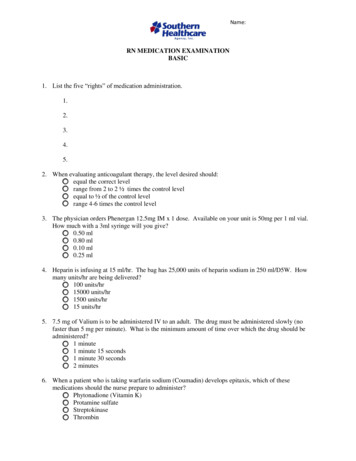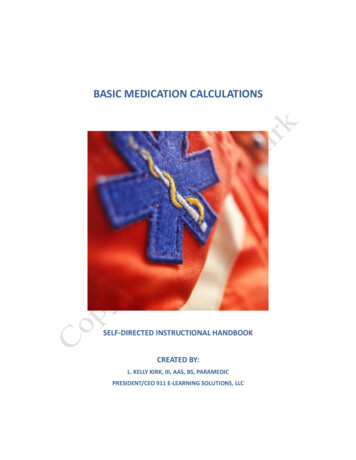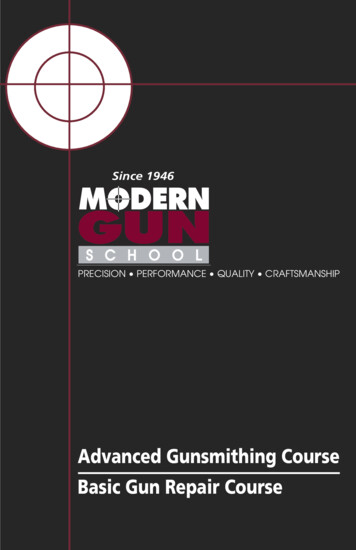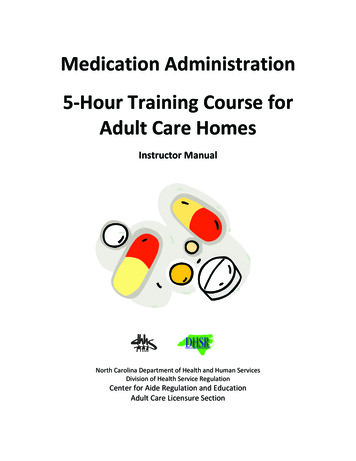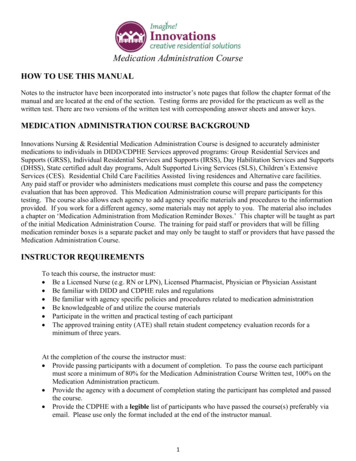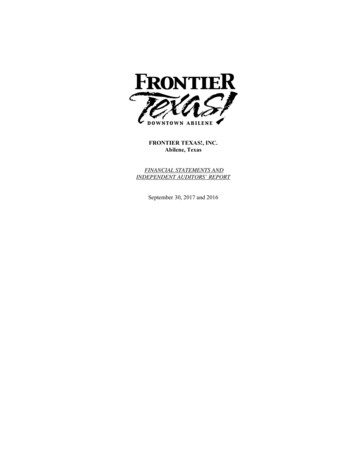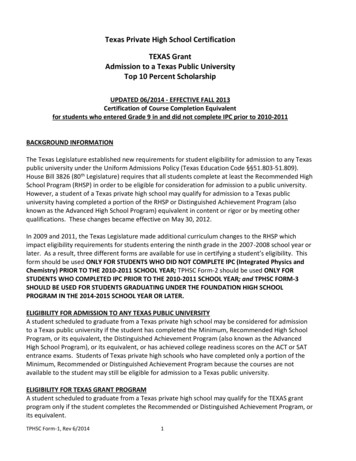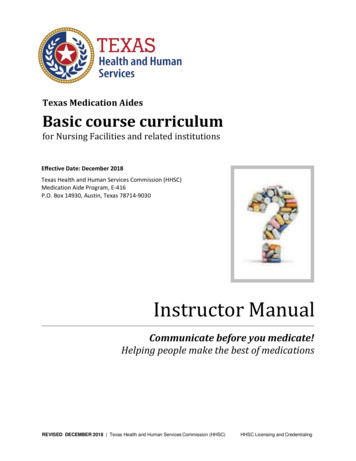
Transcription
Texas Medication AidesBasic course curriculumfor Nursing Facilities and related institutionsEffective Date: December 2018Texas Health and Human Services Commission (HHSC)Medication Aide Program, E‐416P.O. Box 14930, Austin, Texas 78714‐9030Instructor ManualCommunicate before you medicate!Helping people make the best of medicationsREVISED DECEMBER 2018 Texas Health and Human Services Commission (HHSC)HHSC Licensing and Credentialing
TEXAS MEDICATION AIDE AND BASIC COURSE CURRICULUM100‐hour curriculumAcknowledgementsWe would like to extend a very special thank you to the following people who worked many hours inrevising and updating this curriculum. Your cooperation and dedication is appreciated.Darren Christian, R.N., Texas Health and Human Services Commission; Elizabeth Demps, Texas Healthand Human Services Commission; Katherine Hafner, B.S, R.Ph, Fellow in the American Society ofConsultant Pharmacists; Kim Lammons, Texas Health and Human Services Commission; Debi Majo, BSNR.N., TMF Health Quality Institute; Elizabeth McManamy, R.Ph, Texas Health and Human ServicesCommission; Joyce Meredith, Texas Health and Human Services Commission; Carolyn Reese, MSN, R.N.,Blinn College; Brenda Renfro‐King, R.N., McLennan Community College; Jacqueline Smith, Texas Healthand Human Services Commission; Camden Frost, Texas Health and Human Services Commission; SeanSteele, Texas Health and Human Services Commission; Sunny Stout, R.N., Senior Care Centers; MavonTidwell, R.N., Marble Falls High School, Kingsland Hills Care Center; Anne Trejo, Texas Health andHuman Services Commission. 2018 Texas Health and Human Services Commission (formerly Texas Department of Human Services)TEXAS HEALTH AND HUMAN SERVICES COMMISSION (HHSC)1
TEXAS MEDICATION AIDE AND BASIC COURSE CURRICULUM100‐hour curriculumTable of Contents: Medication Aide and basic course curriculumUnit I.Introduction, orientation and basic concepts. 4Unit II.Infection control. 25Unit III.Administration of medication . 48Unit IV.Drugs affecting the Cardiovascular System . 66Unit V.Drugs affecting the Urinary System . 76Unit VI.Drugs affecting the Respiratory System. 78Unit VII.Drugs affecting the Digestive System . 89Unit VIII.Drugs affecting the Central Nervous System . 98Unit IX.Drugs affecting the Musculoskeletal System . 110Unit X.Drugs affecting the Endocrine System . 112Unit XI.Antibiotics and other anti‐infective agents. 117Unit XII.Drugs affecting the eye . 122Unit XIII.Drugs affecting the ear. 124Unit XIV.Drugs affecting the skin . 125Unit XV.Cognitive Impairment . 126Unit XVI.Pediatric Patients . 131Unit XVII.Care Planning Assistance . 132Unit XVIII.Teaching Procedures . 133Unit XIX.Handouts . 143Unit XX.References . 161AppendicesA through N . 1632TEXAS HEALTH AND HUMAN SERVICES COMMISSION (HHSC)
TEXAS MEDICATION AIDE AND BASIC COURSE CURRICULUM100‐hour curriculumCourse activities:The following activities are optional.Activity #1:Group think . 6Activity #2:It is all in the cards! ‐ Homework assignment (Medication Flash Cards)*. 7Activity #3:Mnemonic meds* . 10Activity #4:Jeopardy game (action/reaction game round). 13Activity #5:How do you measure up? (Introduction of Medication Box contents)* . 18Activity #6:Chain of infection game . 28Activity #7:Fits like a glove (two‐part). 41Activity #8:Suit up and prevent infection! . 46Activity #9:Do not mar the MAR – Introduction and demonstration. 50Activity #10:This MAR is from Mars (error check). 63Activity #11:Getting to the heart of the matter (role‐play)Medication Box and cardiovascular system problem solving* . 71Activity #12:An inspirational conversation (role‐play)Medication Box and respiratory system problem solving* . 83Activity #13:See a difference with C‐Diff. (role‐play)Medication Box and digestive system problem solving* . 93Activity #14:A case of nerves (role‐play)Medication Box and central nervous system problem solving*. 105* An asterisk signifies the use of the Medication Flash Cards in the activity.TEXAS HEALTH AND HUMAN SERVICES COMMISSION (HHSC)3
TEXAS MEDICATION AIDE AND BASIC COURSE CURRICULUM100‐hour curriculumTeaching aids/plansCourse outlineUnit I. Introduction, orientation and basic conceptsSection A.Basic Roles and Responsibilities of the Medication Aide.1. Overall requirements, course objectives.a. Self‐evaluation and review.b. Achievements expected.c. Course examinations and final examination.d. Prerequisites for enrolling in the training program.2. Comprehend acts or practices prohibited by medicationaides.3. Understand functions authorized to be performed by themedication aide.4. Identify the legal and ethical implications for the medicationaide.a. Need to administer medications as ordered bypractitioner.b. Administer medications limited under medication aiderules.c. Responsibilities for own actions.d. Additional roles and responsibilities as taught by theinstructors.5. Discuss the types of clinical experiences that the studentswill gain during the portion of the training program.6. Treat residents as individuals and be aware of theirmedication and treatment orders.a. Identify each resident in any setting in the facility.b. Know each patient’s normal activity and recognize thatdeviations from this may be a result of their medicationtherapy.7. Discuss ethical conduct, ethical responsibilities, treatment ofresidents, Health Insurance Portability and AccountabilityAct (HIPAA).8. Discuss what is normal aging: (e.g., physical, social, andemotional).4Medication Aide TrainingProgram Rules.Secure most currentrules and regulations.Discuss Studentsperception of themedication aide role.Medications areadministered only asordered by practitioner.Stress: the importance thatmedication aides actunder supervision ofa licensed nurse –not independently;and the students areresponsible for theirown actions.Indicate that the clinicalportion of themedication aide trainingis “hands‐on” rather thanobservation.Review program trainingrules regarding trainingrequirements.Provide students with: ethics handout; and normal aginghandout.TEXAS HEALTH AND HUMAN SERVICES COMMISSION (HHSC)
TEXAS MEDICATION AIDE AND BASIC COURSE CURRICULUM100‐hour curriculumCourse outlineTeaching aids/plansSection B. Medication overviewIdentify and know drugsfrom the three groups.Discuss current websitesavailable to use for drugreferences such aswww.epocrates‐drugs.comwww. Drugs.comwww.fda.gov1. Drugs commonly used in facilities are grouped according to:a. scheduled (controlled) – Medication which has thepotential to be abused and which must be countedand controlled. Log kept for each medication.b. legend – Require prescription.c. non‐Legend – Can be purchased without a prescription.Must be supplied by the facility for Medicaidresidents. (Over the Counter, OTC)Section C. Reasons for giving drugs.1.2.3.4.5.6.Cure diseaseRelieve symptomsAid in diagnosisReplace body fluidsPrevent illnessMaintain quality of lifeSection D. Problems in drug administration.1. Availability of drugs2. Self‐medications3. Protection of residents against “patent” medicationspurchased over the counter4. Cost of medications5. Modern attitude toward drugs6. Alteration of body functions by drugs7. Determining the need of PRN (as needed) medications8. Reasons to withhold medication9. Residents refusal privilege10. Crushing inappropriate medications11. Risk versus benefits12. Medications with special considerations13. Failure to follow through Establish procedures Facility policiesTEXAS HEALTH AND HUMAN SERVICES COMMISSION (HHSC)Lecture and discuss reasons.Expand upon any areas notcovered in the outline.Discussion of theseproblems; correlateproblems as relatedbetween facility and generalpublic.Discuss hoarding ofmedications.Discuss follow through.Discuss that samplemedications do not meetlabeling requirements.5
TEXAS MEDICATION AIDE AND BASIC COURSE CURRICULUM100‐hour curriculumTeaching aids/plansACTIVITY #1: Group thinkExplainDivide Learners into three teams. Ask teams to choose which ofthe three medication groups (from the review on SectionB/Medication Overview) they want to represent during theactivity. Each team will each represent one of the followinggroups:1. legend;2. non‐legend (over‐the‐counter); and3. scheduled or controlled.The purpose of the activity is to distinguish similarities anddifferences of the three medication group categories. Placespecial emphasis on prescription medications (that fall underboth legend and scheduled/controlled groups).Teams will review a sample collection of various medications(provided by the Instructor) placed in one large grouping on atable in the front of the classroom. Teams will come up to thefront table and begin to arrange medications that belong intheir team’s assigned medication group.As Instructor, you willsupply a display of a varietyof different medications (inempty containers or inphoto form on the fronttable in the room.Each team will have at leastsix different medicationsthat appropriately fit intotheir group classification oflegend, non‐legend orscheduled/controlled.For both legend andscheduled/controlled, useonly empty prescriptionbottles with a label (so thatno actual medication isprovided).Teams will have to work together to determine how toaccurately group the scheduled samples from the legendsamples, as both of these groups require a prescription.Spend extra time reviewing the samples that are considered tobe in the controlled/scheduled group category and why.6TEXAS HEALTH AND HUMAN SERVICES COMMISSION (HHSC)
TEXAS MEDICATION AIDE AND BASIC COURSE CURRICULUMACTIVITY #2: Homework assignmentIt is all in the cards! Medication Flash Cards100‐hour curriculumTeaching aids/plansExplainInstruct Learners to reviewthe recommended list ofmedications (Top 200) inAppendix C for the semestercourse. Starting from thetop and using thealphabetical class roster,assign five medications toeach student.StateLearning all aspects of eachmedication will beimportant to your positionin the facility. The morebackground and familiarityyou have with a number ofdifferent medications, themore you will recognizepotential errors andimprove your skills. Evenmore important is yourconnection with eachResident. A solid knowledgebase of medications willimprove your efficiency andaccuracy.FRONT OF THE MEDICATION FLASH CARD(See Appendix A for full size)The purpose of the activity is to provide the opportunity forLearners to individually research and complete medicationprofiles for use by the class over the course of the semester.Learners will fill in the information (via online research) andbring the completed cards to class. Each Learner willresearch and complete five cards for use in class activities.TEXAS HEALTH AND HUMAN SERVICES COMMISSION (HHSC)Your first assignment is tocreate your own deck ofoversize Medication FlashCards. Take the fivemedications assigned to youand research each oneonline at home or at thelibrary, printer business, etc.Fill in the blank copies youreceive today and bringthem back completed forthe class to use.7
TEXAS MEDICATION AIDE AND BASIC COURSE CURRICULUM100‐hour curriculumACTIVITY #2: It is all in the cards!Medication Flash Cards (cont’d)Teaching aids/plansExplainReview the backside of theMedication Flash Card. Thegraphics provide all of thebody systems, the threedrug groups, the threeforms of medications and aspace to write in medicationwarning information.StateIn researching your fivemedications, use this side ofthe card to either check orcircle the main body systemaffected, the form each drugis available and the type ofdrug group.Use the warning area tofill‐in any additionalmedication informationimportant to provide as awarning on the druglabeling.BACK OF THE MEDICATION FLASH CARD(See Appendix B for full size)Learners must also complete the information onthe back of the card.8TEXAS HEALTH AND HUMAN SERVICES COMMISSION (HHSC)
TEXAS MEDICATION AIDE AND BASIC COURSE CURRICULUMCourse outlineSection E. Drug legislation1.2.3.4.Federal Food, Drug, and Cosmetic Act.Texas Dangerous Drug LawsNurse Practice ActControlled Substance Acta. Classification of controlled substances. Schedule I –highest abuse potential Schedule II Schedule III Schedule IV Schedule V – lowest abuse potentialb. Special Considerations Schedule I – not medically approved or very limitedapproval. Schedule II – most abused, must count Schedule III, IV, V – must count per facilityprocedure.5. Facility Standards for Participation under Medicare andMedicaid6. Facility Standards7. Non‐FDA approved drugs obtained from outside the U.S.100‐hour curriculumTeaching aids/plansUse the Medication FlashCards to set up for anotherquick activity involving thedifferent classifications(five) for controlledsubstances.The activity to follow willcreate a team‐based gameusing specific drugsidentified for Learners toprocess from each of thefive classification groups.Teams will create amnemonic device to helpmemorize aspects for eachmedication.As Instructor, choose twomedications from theMedication Flash Cards thatrepresent each of the fiveschedule classifications forcontrolled substances.If a card is unavailable fromthe deck, use the Top 200List (Appendix C) to choosetwo drugs for each schedulecategory.Briefly discuss Section E.Review legislation underFederal and State Food,Drugs, and Cosmetic Act;state dangerous drug lawsand Controlled SubstancesAct (consultant Pharmacistprovides discussion here).Discuss problems with selfmedication, transferringbetween containers andlabeling requirements here.TEXAS HEALTH AND HUMAN SERVICES COMMISSION (HHSC)9
TEXAS MEDICATION AIDE AND BASIC COURSE CURRICULUM100‐hour curriculumACTIVITY #3: Mnemonic medsTeaching aids/plansSchedule classification mnemonics:Choose at least twomedications for each of thefive controlled substanceclassifications (Schedulesone through five).The purpose of the activity is to challenge Learners to create ameans to memorize complex medication characteristics using amnemonic device.A mnemonic device is a technique you can use to help improveyour memory of information. Using the definition of yourcontrolled drug classification group and one of the MedicationFlash Cards provided by your Instructor, create a rhyme or a newfun way with words to remember characteristics of themedication.Sample mnemonic (Rhyme):I’m from Schedule IV, let me tell you more If you take me as prescribed, you may sleep on the floor.I balance your brainand promote deep sleep.And I’m easily abused, but not as much as Schedule III.My generic name is Zolpidem.Take me as prescribedand sink into R.E.M.Answer: AmbienOther mnemonics may include the following types: Musical mnemonic – Use a popular song/tune to make up asong using the information. For example, use the medicationinformation as the words to an Adele or Tina Turner song. Expression mnemonic – Use the first letter of each word tocome up with a name, phrase or thing.(e.g., Ambien is ALICE MAY BE INCOHERENT EVERY NIGHT.) Name mnemonic – Use the word to make up a person. Youcan even expand on information about the person to helpyou remember more info! (e.g., Ambien might be A.M. Bien,who sleeps well!) Image mnemonic – Use the image of a BAT to rememberthree types of depressant drugs: Barbiturates, Alcohol andTranquilizers)Use the mnemonic exampleto illustrate how to create aword memory game.ExplainDivide the class into fiveteams. Each team will beassigned one of theSchedule/Classificationgroups for controlledsubstances. Assign eachteam two medicationsaccording to their team’sassigned classificationgroup.Have each team make up arhyme or create anothermnemonic device forremembering characteristicsfor their med. Thistechnique may be used tohelp the class learn how toidentify and memorizecomplex medicationinformation.Make sure the mnemonicincludes the schedulenumber classification and atleast one importantcharacteristic accurate tothe drug.Source: University of Central Florida, Nine Types of Mnemonicsfor Better Memory (PDF)10TEXAS HEALTH AND HUMAN SERVICES COMMISSION (HHSC)
TEXAS MEDICATION AIDE AND BASIC COURSE CURRICULUM100‐hour curriculumCourse outlineTeaching aids/plansSection F. Personnel involved in Residents’ drug therapy.Identify the roles of thephysician, pharmacist,registered nurse, andlicensed vocational nurse.1. Physician (Nurse Practitioner, Physician Assistant)2. Pharmacist3. Registered Nurse and Licensed Vocational Nurse, andMedication Aidesa. Preparing drugs for administrationi. Equipmentii. Procedureb. Administration of medicationsc. Observing, documenting, and reporting reactions tomedicine4. Therapist5. The role of the medication aide in relation to the health careteam.Section G. Resource reference for drug information1. Identify various up‐to‐date textbooks and materials used inthe training program and found in facilities.2. Demonstrate the ability to use these resources.3. Discuss several common drug standards and references.4. Select various (common) references where information maybe obtained concerning drugs.5. Prepare practice problems to demonstrate resource use andfamiliarity.6. Identify procedures for contacting the pharmacist for druginform
d. Prerequisites for enrolling in the training program. 2. Comprehend acts or practices prohibited by medication aides. 3. Understand functions authorized to be performed by the medication aide. 4. Identify the legal and ethical implications for the medication aide. a. Need

